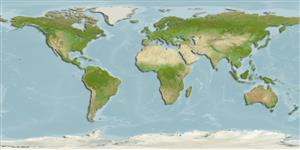Environment: milieu / climate zone / depth range / distribution range
Οικολογία
Θαλασσινό(ά) βενθικό(ς). Temperate
Κατανομή
Χώρες | Περιοχές FAO | Οικοσυστήματα | Παρουσίες | Point map | Εισαγωγές | Faunafri
Southwest Pacific: Lord Howe Island, Australia.
Μέγεθος / Βάρος / Age
Maturity: Lm ? range ? - ? cm
Max length : 3.2 cm SL αρσενικό/απροσδιόριστο; (Ref. 49352)
Ραχιαίες άκανθες (συνολικά) : 13; Μαλακές ραχιαίες ακτίνες (συνολικά) : 10; Εδρικές άκανθες: 1; Μαλακές εδρικές ακτίνες: 8 - 9; Σπόνδυλοι: 28. Upper jaw relatively short, 10-11% SL; a stubby fleshy cirrus near distal end of maxilla (Ref. 39602).
Inhabits rock reef (Ref. 75154).
Life cycle and mating behavior
Maturities | Αναπαραγωγή | Spawnings | Egg(s) | Fecundities | Προνύμφες
Poss, S.G., 1999. Aploactinidae. Velvetfishes. p. 2354-2358. In K.E. Carpenter and V.H. Niem (eds.) FAO species identification guide for fishery purposes. The living marine resources of the Western Central Pacific. Vol. 4. Bony fishes part 2 (Mugilidae to Carangidae). Rome, FAO. 2069-2790 p. (Ref. 39602)
IUCN Red List Status (Ref. 130435)
Threat to humans
Harmless
Human uses
Εργαλεία
Special reports
Download XML
Διαδικτυακές πηγές
Estimates based on models
Preferred temperature (Ref.
123201): 20.6 - 22.2, mean 21.5 °C (based on 8 cells).
Phylogenetic diversity index (Ref.
82804): PD
50 = 0.5000 [Uniqueness, from 0.5 = low to 2.0 = high].
Bayesian length-weight: a=0.01000 (0.00244 - 0.04107), b=3.04 (2.81 - 3.27), in cm total length, based on all LWR estimates for this body shape (Ref.
93245).
Τροφικό Επίπεδο (Ref.
69278): 3.2 ±0.3 se; based on size and trophs of closest relatives
Fishing Vulnerability (Ref.
59153): Low vulnerability (10 of 100).
